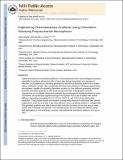Engineering chemoattractant gradients using chemokine-releasing polysaccharide microspheres
Author(s)
Wang, Yana; Irvine, Darrell J
DownloadIrvine_Engineering chemoattractant.pdf (1.854Mb)
PUBLISHER_CC
Publisher with Creative Commons License
Creative Commons Attribution
Terms of use
Metadata
Show full item recordAbstract
Spatial and temporal concentration gradients of chemoattractants direct many biological processes, especially the guidance of immune cells to tissue sites during homeostasis and responses to infection. Such gradients are ultimately generated by secretion of attractant proteins from single cells or collections of cells. Here we describe cell-sized chemoattractant-releasing polysaccharide microspheres, capable of mimicking chemokine secretion by host cells and generating sustained bioactive chemokine gradients in their local microenvironment. Exploiting the common characteristic of net cationic charge and reversible glycosaminoglycan binding exhibited by many chemokines, we synthesized alginate hydrogel microspheres that could be loaded with several different chemokines (including CCL21, CCL19, CXCL12, and CXCL10) by electrostatic adsorption. These polysaccharide microspheres subsequently released the attractants over periods ranging from a few hours to at least 1 day when placed in serum-containing medium or collagen gels. The generated gradients were able to attract cells more than hundreds of microns away to make contact with individual microspheres. This versatile system for chemoattractant delivery could find applications in immunotherapy, vaccines and fundamental chemotaxis studies in vivo and in vitro.
Date issued
2011-04Department
Massachusetts Institute of Technology. Department of Biological Engineering; Massachusetts Institute of Technology. Department of Chemical Engineering; Massachusetts Institute of Technology. Department of Materials Science and Engineering; Ragon Institute of MGH, MIT and Harvard; Koch Institute for Integrative Cancer Research at MITJournal
Biomaterials
Publisher
Elsevier
Citation
Wang, Yana, and Darrell J. Irvine. “Engineering Chemoattractant Gradients Using Chemokine-Releasing Polysaccharide Microspheres.” Biomaterials 32, no. 21 (July 2011): 4903–4913.
Version: Author's final manuscript
ISSN
01429612
1878-5905